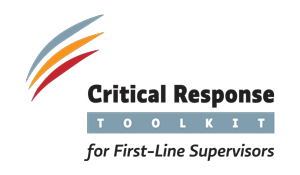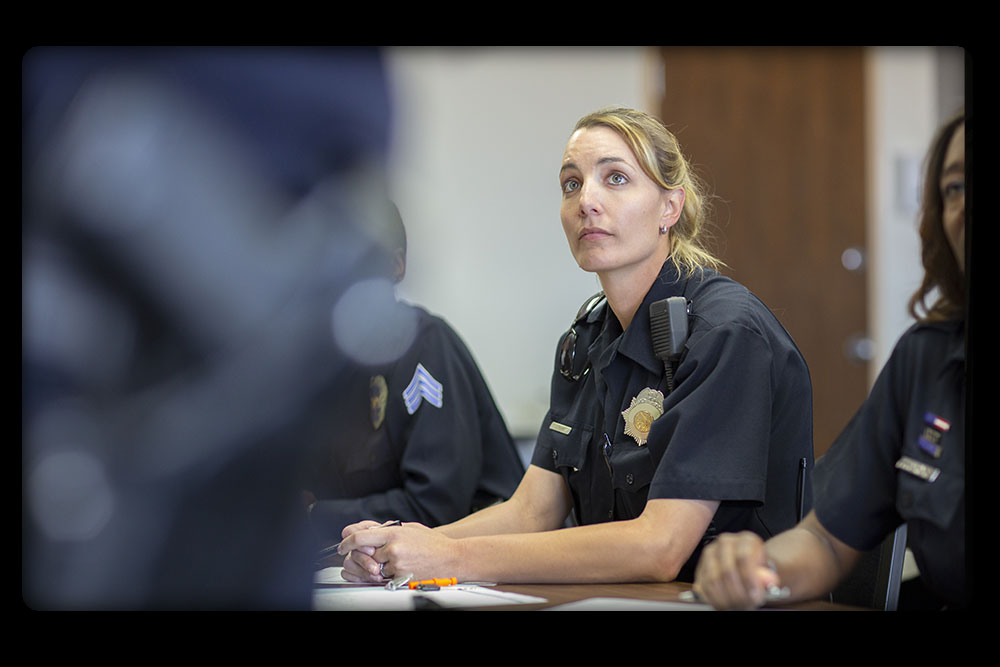

Preparation is key to the successful resolution of critical incidents. It is vital that law enforcement agencies invest in their first-line supervisors (FLSs) by preparing and training them well before they encounter a critical incident.
Four Key Action Items
Here are four key action items for an agency to complete to prepare their first-line supervisors before a critical incident.
- Provide training before members start their new role as supervisor and ensure that the training is scenario-based
- Train for critical incidents with other department units and outside agencies and their supervisors
- Give new FLSs opportunities to be observed in the field and shadow veteran supervisors
- Proactively establish relationships with community stakeholders
1. Provide training before members start their new role as supervisor and ensure that the training is scenario-based.
When supervisors arrive on scene of a critical incident, they will fall back on their training. That is why it is imperative that critical incident training for first-line supervisors take place before they start their new role.
 These trainings must involve more than PowerPoints and lectures on administrative tasks. New supervisors need to be engaged and challenged with real-life scenarios that give them the opportunity to test their skills prior to being on the street. This is especially important for critical incidents, where the situations are dynamic and the stakes are high. These trainings must involve more than PowerPoints and lectures on administrative tasks. New supervisors need to be engaged and challenged with real-life scenarios that give them the opportunity to test their skills prior to being on the street. This is especially important for critical incidents, where the situations are dynamic and the stakes are high.
Tabletop exercises that simulate a critical incident allow new supervisors to familiarize themselves with the necessary actions they must take in an emergency situation. While these exercises will be less stressful than a real incident, if agencies can simulate a stressful situation in practice, supervisors will have a more realistic idea of how they will respond in the field. Mistakes can be corrected in advance, instead of making them during a real incident. Each tabletop exercise should be followed by a thorough debrief to discuss the experience. This allows new supervisors to both observe and practice organizing and conducting meaningful debriefs.
If resources are available, first-line supervisors should be given the opportunity to attend trainings outside of their department. This gives new supervisors opportunities to advance their skills and gain new perspectives, which can benefit the whole department.
 Key Topics to Include in FLS Training: Key Topics to Include in FLS Training:
NOTE: While these skills are important for the everyday work of First-Line Supervisors, they are especially important to critical incidents.
-
Transitioning to the Role of Supervisor
- The transition from officer to sergeant is not easy. In fact, it may be the most difficult transition an officer faces in their career.
- There is a shift in mindset from a patrol officer to now managing a group of patrol officers.
.
-
Personnel Management
- As the name implies, first-line supervisors have a duty to manage and supervise their officers.
- There are different management styles, each with pros and cons.
- New supervisors should learn about each one and work towards developing their own personal management style.
-
Leadership Skills
- Not only do supervisors need to manage their officers, they need to show strong leadership skills at all times, especially under pressure.
- While some people may be natural leaders, there is always room to grow and practice leadership skills.
-
Crime Scene Management
- First-line supervisors are in charge of:
- Securing the scene
- Directing personnel (and limiting unnecessary personnel from the scene)
- Ensuring evidence is properly examined and collected.
-
Officer Safety and Wellness
- Law enforcement officers are regularly exposed to a range of traumatic scenes. This can take a toll on one’s physical and mental well-being.
- Supervisors should know the safety and wellness resources that are available to officers.
- Supervisors should also learn how to recognize warning signs that officers are exhibiting stress, as well as when to intervene with officers who may need assistance.
- Supervisors must foster an environment where it is not perceived as “weak” to ask for help.
-
Community Engagement
- Every supervisor will have to engage with the community during incidents
- Improving communication skills, with a focus on community stakeholders, is essential.
- Supervisors should understand how social and traditional news media operate and how to work with reporters.
- Prior to a critical incident, departments should train first-line supervisors in their agency’s media and social media policies.
- Depending on the agency, if first-line supervisors are not authorized to update the media, they should know where to direct the public to go for current and accurate information on a critical incident.

Tucson Police Department: New Supervisor Program
2. Train for critical incidents with other department units and outside agencies and their supervisors.
 Critical incidents often include other department units and outside agencies as part of the response. Therefore, trainings should incorporate those other agencies and their supervisors. Critical incidents often include other department units and outside agencies as part of the response. Therefore, trainings should incorporate those other agencies and their supervisors.
These trainings should include scenarios for the group to practice and debrief. Collaborative training also provides an opportunity to identify and discuss any potential problems or gaps in resources. It is also helpful to review the other agencies’ policies on critical incidents and create Memorandums of Understanding (MOUs) to formalize partnerships and establish protocols when necessary.
Sometimes policies may conflict or use terms used that other agencies are unfamiliar with. For example, some agencies use 10-codes while others use plain-language, different agencies will use acronyms unique to their departments, or have different policies regarding speaking to the media and sharing information with the public. It is important to discuss these topics in advance, before an incident arises.
Suggested agencies to include:
- Emergency Communication Centers
- Fire and EMS departments
- Private security at venues such as stadiums and malls
- Local fusion centers
- Other regional agencies that may be part of a critical incident response
- Public and private mental health departments and organizations

3. Give new FLSs opportunities to be observed in the field and shadow veteran supervisors.
In addition to training, new supervisors may benefit from participating in an observation or shadowing experience. Experiential learning is critical. Having someone else with whom to discuss ideas and issues helps FLSs develop their own decision-making skills. Shadowing opportunities can be built into the FLS training as a formal FTO program or it can be done informally.
4. Proactively establish relationships with community stakeholders.
The community can be a great resource for law enforcement agencies, especially during and following a critical incident.
There are multiple benefits to establishing a positive relationship with the community in advance of a critical incident. Supervisors will become familiar with the people they police and the geographical layout of the area, helping to ensure that they can make quick and informed decisions during a critical incident.
Through regular interaction with community members and leaders, supervisors will also become familiar with key stakeholders, including school administrators, religious leaders, business community representatives, and medical center staff. These individuals can be helpful in providing intelligence and additional resources when necessary.

Action Items for Supervisors:
 1) Become familiar with the layout of major community gathering places, such as malls, stadiums, public parks and event venues, and ask about their emergency response plans. 1) Become familiar with the layout of major community gathering places, such as malls, stadiums, public parks and event venues, and ask about their emergency response plans.
2) Meet with key internal and external stakeholders.
- Internal stakeholders can include city or county agencies like:
Public Works Department, Human Resources, Community Services, Economic Development, Mental Health, and others. They will have connections to resources that could be crucial to a successful response.
- External stakeholders include:
School administrators, religious leaders, business community representatives, medical center staff and discuss how to partner better during critical incidents.
3) Keep lines of communication open with stakeholders both during and after a critical incident, keeping them updated and seeing if they have useful information to provide.
4) Address any misinformation about critical incidents. Community stakeholders can be especially well-positioned to help dispel rumors that often arise after a critical incident.
 Metropolitan Nashville Police Department: Metropolitan Nashville Police Department:
Response to Mall Shooting
This project was supported, in whole or in part, by cooperative agreement number 2018CKWXK016 awarded to the Police Executive Research Forum by the U.S. Department of Justice, Office of Community Oriented Policing Services. The opinions contained herein are those of the author(s) or contributor(s) and do not necessarily represent the official position or policies of the U.S. Department of Justice.
|


![Managing a Critical Incident Managing a Critical Incident [section header]](/assets/images/CRTimages/managingincident_sh.png)

![Go to the Helpful Resources section Helpful Resources [section header]](/assets/images/CRTimages/helpfulresources_sh.jpg)


 These trainings must involve more than PowerPoints and lectures on administrative tasks. New supervisors need to be engaged and challenged with real-life scenarios that give them the opportunity to test their skills prior to being on the street. This is especially important for critical incidents, where the situations are dynamic and the stakes are high.
These trainings must involve more than PowerPoints and lectures on administrative tasks. New supervisors need to be engaged and challenged with real-life scenarios that give them the opportunity to test their skills prior to being on the street. This is especially important for critical incidents, where the situations are dynamic and the stakes are high. Key Topics to Include in FLS Training:
Key Topics to Include in FLS Training:
 Critical incidents often include other department units and outside agencies as part of the response. Therefore, trainings should incorporate those other agencies and their supervisors.
Critical incidents often include other department units and outside agencies as part of the response. Therefore, trainings should incorporate those other agencies and their supervisors.  1) Become familiar with the layout of major community gathering places, such as malls, stadiums, public parks and event venues, and ask about their emergency response plans.
1) Become familiar with the layout of major community gathering places, such as malls, stadiums, public parks and event venues, and ask about their emergency response plans.